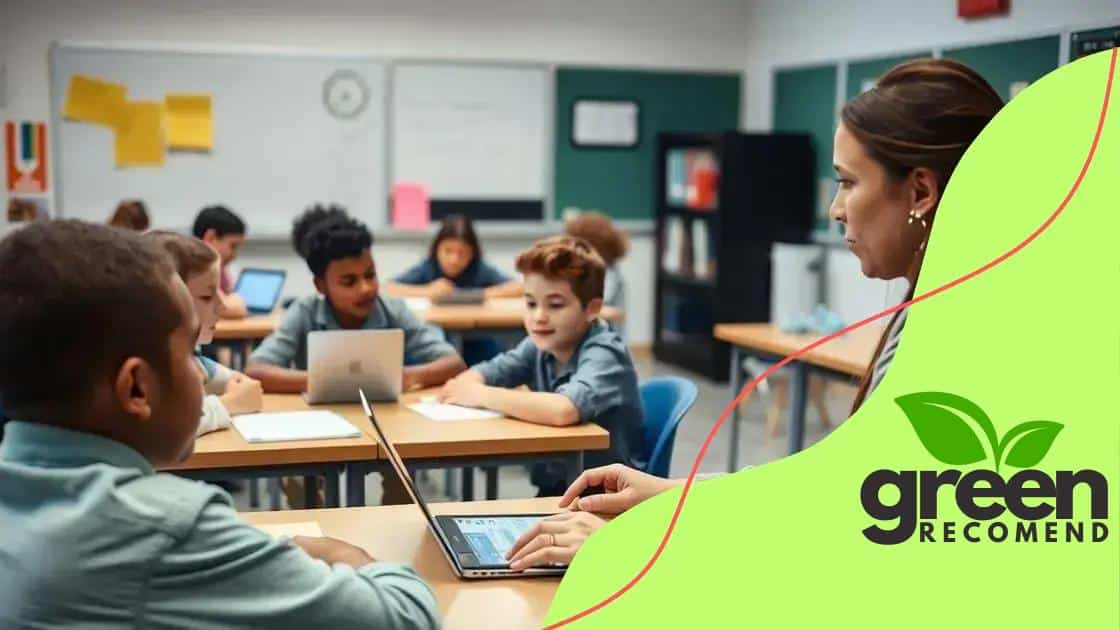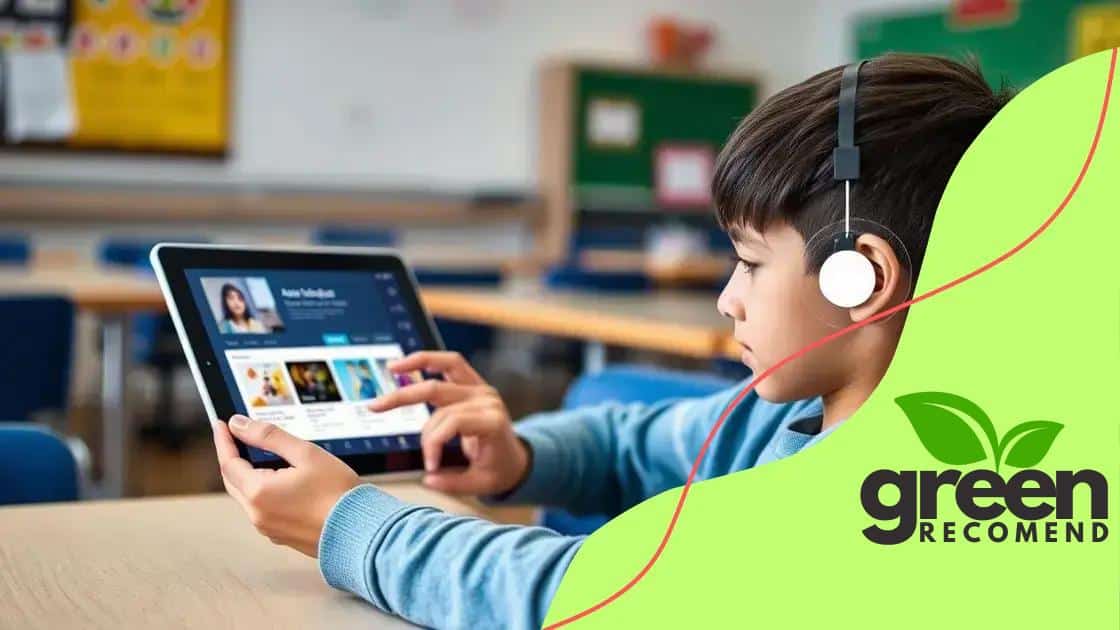AI tools for monitoring and improving student engagement

AI tools for monitoring and improving student engagement enhance learning by personalizing experiences, tracking participation, and providing real-time feedback, leading to better academic outcomes.
AI tools for monitoring and improving student engagement are changing how educators interact with students. Have you ever wondered how technology can enhance learning experiences and foster a vibrant classroom atmosphere? Let’s dive into the impactful role of AI in education.
Understanding the importance of student engagement
Understanding the importance of student engagement is key to improving learning outcomes. When students are actively involved in their education, they tend to perform better and retain information longer. Engaged students are not just passive recipients of information; they interact with the content, participate in discussions, and develop critical thinking skills.
Benefits of Student Engagement
There are several benefits to fostering an engaging learning environment:
- Improved academic performance
- Higher retention rates
- Enhanced motivation and enthusiasm for learning
- Better social skills and teamwork abilities
A classroom filled with engaged learners creates a vibrant atmosphere. It encourages collaboration and communication, making learning enjoyable. Schools need to implement strategies to promote student engagement. This can include incorporating technology, like AI tools, that monitor participation and provide feedback.
Strategies to Foster Engagement
To boost student engagement, consider these strategies:
- Integrate interactive technology
- Encourage group projects
- Use gamification techniques
- Provide choices in learning tasks
Using technology in the classroom allows educators to track which methods resonate with their students. When students are engaged, they are more likely to take ownership of their learning. This ownership leads to a more personalized and effective learning experience.
In conclusion, the importance of student engagement cannot be overstated. By actively working to engage students, educators create opportunities for deeper understanding and skill development. This ultimately prepares students for success in their academic pursuits and future careers.
Top AI tools for tracking student participation
When it comes to enhancing student engagement, understanding the top AI tools for tracking student participation is critical. These tools help educators monitor how involved students are in the learning process. They provide valuable data that can shape teaching methods and improve overall educational outcomes.
Key AI Tools for Tracking Participation
Several AI tools stand out in the educational landscape. They are designed to help teachers gain insights into student activity:
- ClassDojo: This platform engages students and tracks behavior in real-time.
- Kahoot!: A game-based learning tool that measures participation through quizzes.
- Edmodo: A learning management system that tracks assignments and online participation.
- Google Classroom: Integrates with various tools to analyze student submissions and engagement.
Using these AI tools allows schools to create a more interactive environment. When teachers have access to engagement data, they can adjust their lessons to meet student needs. For instance, if students are struggling with a concept, immediate feedback can lead to changes in instruction.
Benefits of Using AI Tools
The integration of AI technology into classrooms offers numerous advantages:
- Real-time tracking of attendance and participation
- Data-driven insights for personalized learning
- Improvement in student motivation
- Streamlined communication between students and teachers
Moreover, with AI tools in place, educators can identify trends over time. This data can show which teaching strategies work best and which areas might need more attention. As the educational landscape evolves, these tools provide a pathway to innovative teaching methods that keep students engaged and learning effectively.
How AI improves personalized learning experiences

AI improves personalized learning experiences by tailoring educational content to meet the unique needs of each student. With the help of AI, it’s possible to analyze learning styles and preferences, enabling a customized approach to instruction.
Key Features of AI in Personalized Learning
Several features make AI tools valuable in creating personalized learning experiences:
- Adaptive Learning Technologies: These tools adjust the difficulty of tasks based on student performance.
- Data Analysis: AI analyzes data to identify knowledge gaps and recommend resources.
- Real-Time Feedback: Immediate feedback helps students understand their mistakes and learn from them.
- Customized Learning Paths: Students can progress at their own speed, spending more time on challenging concepts.
By leveraging these features, educators can design lessons that resonate with students, keeping them engaged and motivated. Additionally, the integration of AI allows instructors to focus on areas where students need the most support. Personalized learning encourages students to take charge of their education, making learning more relevant and enjoyable.
Benefits of Personalized Learning Through AI
Employing AI in personalized learning has several advantages:
- Increased student engagement and motivation
- Better understanding of individual learning styles
- Improved academic performance
- Enhanced critical thinking and problem-solving skills
As technology continues to evolve, the potential for AI tools to enhance personalized learning experiences becomes even greater. Teachers can gain insights that were previously unavailable and create a classroom environment where students thrive.
Case studies: Successful use of AI in classrooms
Case studies showcasing the successful use of AI in classrooms reveal how technology enhances learning experiences. Many schools have adopted AI tools, leading to improved student engagement and performance. These real-world examples demonstrate the positive impact of AI on education.
Example 1: Personalized Learning at XYZ High School
At XYZ High School, AI-driven platforms were introduced to personalize learning for each student. Teachers used data analytics to tailor assignments based on individual strengths and weaknesses. Students reported feeling more motivated and engaged in their learning, leading to a 20% increase in overall test scores.
Example 2: Increased Participation with AI Tools at ABC Middle School
ABC Middle School implemented AI tools like interactive quizzes and gamification strategies to track student participation. Teachers noticed that students were more inclined to participate in lessons. The implementation led to higher attendance rates and improved classroom dynamics.
Example 3: Real-Time Feedback in DEF Academy
DEF Academy used AI to provide real-time feedback on student performance. Through AI assessments, students received immediate insights into their understanding of the material. This approach not only helped teachers identify struggling students but also encouraged students to self-correct and improve.
Key Takeaways from these Case Studies
The case studies indicate several benefits of integrating AI into education:
- Enhanced student engagement and motivation.
- Tailored learning paths that adapt to individual needs.
- Improved academic performance and feedback mechanisms.
- Increased collaboration between students and teachers.
These examples highlight how AI in classrooms is not just a trend but a transformative approach to education. Schools that embrace this technology can create engaging and effective learning environments for their students.
Challenges and solutions in implementing AI tools
Implementing AI tools in education comes with several challenges. Understanding these challenges and finding effective solutions is crucial for schools aiming to enhance learning through technology.
Common Challenges of AI Implementation
One major challenge is the lack of proper training for teachers. Without adequate training, educators may struggle to use AI tools effectively. Moreover, schools may face resistance from staff who are skeptical about adopting new technologies. Another challenge is data privacy. Collecting and analyzing student data raises concerns about confidentiality and security. Additionally, the cost of implementing AI systems can be a barrier for many schools, especially those on tight budgets.
Effective Solutions to Overcome Challenges
To address these challenges, schools can take several steps:
- Invest in Training: Providing ongoing professional development ensures teachers feel confident using AI tools.
- Engage Stakeholders: Involve teachers in the selection and implementation of AI tools to foster buy-in and reduce resistance.
- Prioritize Data Security: Create clear policies on data usage and invest in secure systems that protect student information.
- Seek Funding Opportunities: Look for grants and partnerships that can help cover the costs of technology.
By tackling these issues head-on, schools can pave the way for successful AI integration. Schools that embrace the change can lead to better educational outcomes. The journey may be challenging, but implementing AI tools can ultimately create engaging and personalized learning environments for all students.
FAQ – Frequently Asked Questions about AI Tools in Education
How can AI tools improve student engagement?
AI tools can tailor learning experiences, making lessons more interactive and personalized, which boosts student interest and participation.
What challenges do schools face when implementing AI tools?
Common challenges include lack of training for teachers, data privacy concerns, resistance to change, and costs associated with new technology.
What are some effective solutions for these challenges?
Investing in teacher training, engaging staff in the decision-making process, ensuring data security, and seeking funding opportunities are all effective strategies.
Can AI tools help with personalized learning?
Yes, AI tools analyze student performance and adapt learning materials to suit individual needs, leading to better academic outcomes.





